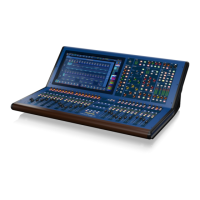141 HD96-24-CC-TP User Manual
TC Electronic VSS3 Reverb
The TC VSS3 reverb is a simplied version of the VSS4 reverb. It still has the great TC sound but is less DSP intensive and only takes 1 slot space instead of the 3 that the
VSS4 takes. The VSS3 enables you to add the softest and cleanest ambience to your work that you have ever heard. The wide range of presets will give you the exact
reverb you are looking for.
Constructing a Reverb Preset
The relationship of Early Reections and the Reverb tail is very important in this algorithm. Adjusting the balance between the Early Lev and the Rev Lev parameters is
one of the easier ways to make a HUGE dierence in the sound of your reverb! When you start building your preset you should try this:
• • First turn the Rev Lev all the way down. In a send/return conguration, push up the return level. You should now hear Early Reections and no Reverb Tail.
• • Then begin changing the Early parameters until you select a room shape that compliments the program material.
• • Re-adjust the wet/dry balance until it is pleasing, then bring up the Rev Lev until the tail of the reverb becomes audible. Add just enough tail to make it work
together.
• • Adjust the Decay time accordingly.
• • On some presets you may choose to have very little Early Reections or none at all. Certain “ambience” style presets might have little or no “tail”. This is up to you.
The VSS3 was designed to have the smoothest Reverb tail ever developed, but it is the Early Reections that dene the “personality” of the room, so try and
experiment with this relationship! By using these parameters correctly, you can create a BIG sound without having a mix swimming in reverb wash.
Early Reections dene the actual feel of the room, where the Reverb tail is the less dened “bowl” of reections that follows. The major part of the Early
Reection patterns of the VSS3 are simulations of existing rooms and are based on a large number of reections (40-100), which have been processed through an
advanced algorithm.
There are a number of dierent types and sizes covering a lot of dierent acoustic spaces that you need for music and postproduction. As the patterns are simulations
of real rooms, the delay times of the rst reections are sonic and spatially “connected” to the direct signal. Using Pre Delay together with Early Reections should
therefore be considered very carefully, as the acoustic space created by the pattern tends to “collapse” if too much Pre Delay is added. If you want the well-known
“slap back” reverb eect, you should use Rev Delay on the Reverb tail instead and reduce the level of the Early Reections.

